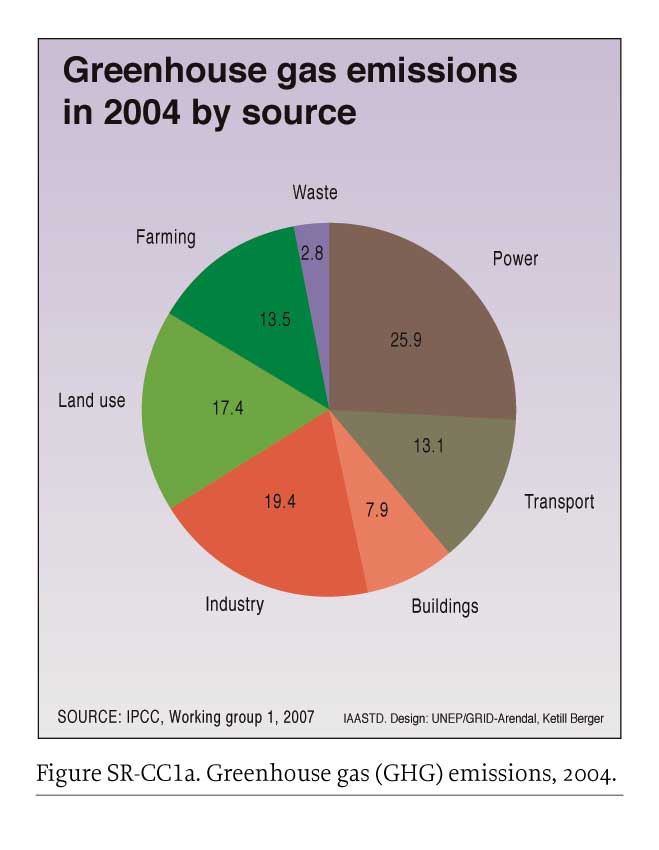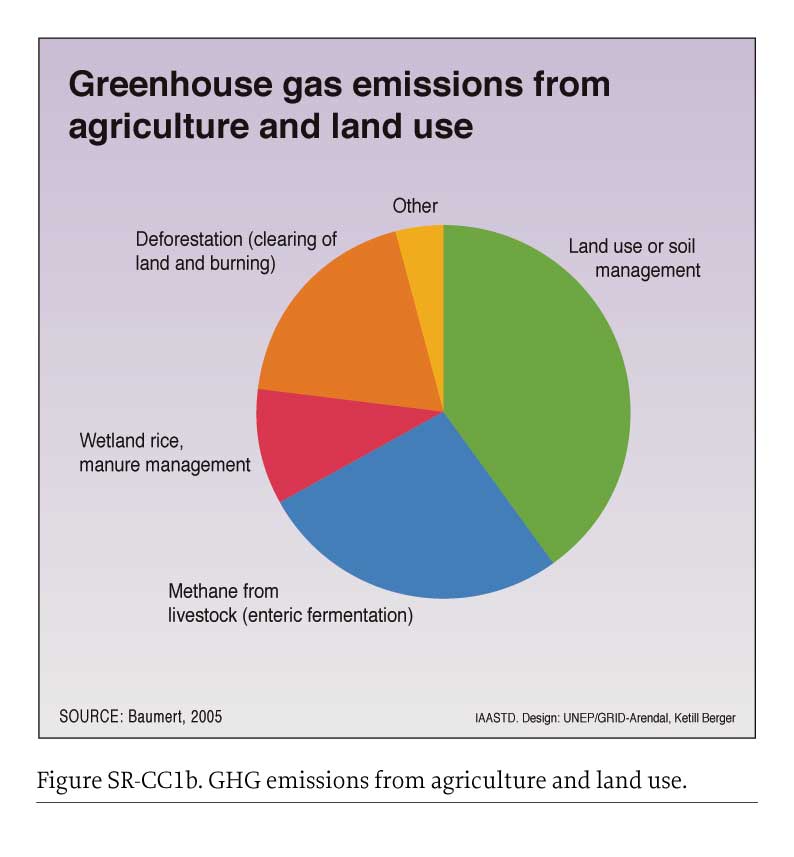• Altered radiative fluxes and evaporation from newly bare soils [Global Chapter 3].
• Increased geographical distance between producer and consumer, together with regional agricultural specialization, has resulted in greater energy use for transportation.
Overall, agriculture (cropping and livestock) contributes 13.5 % of global greenhouse gas emissions mostly through emissions of methane and nitrous oxide (about 47% and 58% of total anthropogenic emissions of CH4 and N2O, respectively). However reports from other estimate the emissions from livestock alone to account for 18% of total emissions. This figure includes the entire commodity chain for livestock. Land use, land use change and forestry contribute another 17.4% mostly as carbon dioxide. Most of greenhouse gas emissions are from land use changes and soil management (40%), enteric fermentation (27%), and rice cultivation (10%). As diets change and there is more demand for meat, there is the potential for increased GHG emissions from agriculture. The relative contribution varies by region; in NAE it is estimated to be in the range of 7-20% [Global Chapter 1; NAE Chapter 2]. The highest emissions of greenhouse gases from agriculture are generally associated with the most intensive farming systems. Sub-Saharan Africa, on rainfed agriculture, contributes the least in terms of GHG emissions and yet it is among the most vulnerable regions to the impacts of climate change [NAE Chapter 3; SSA Chapter 1] due to multiple stresses, including the heavy reliance on rain fed agriculture, poverty, weak institutional structures and low adaptive capacity. Changes in land use have negatively affected the net ability of ecosystems to sequester carbon from the atmo-

Figure SR-CC1a. Greenhouse gas (GHG) emissions, 2004.
sphere. For instance, the carbon rich grasslands and forests in temperate zones have been replaced by crops with much lower capacity to sequester carbon. Despite a slow increase in forests in the northern hemisphere, the overall benefits in terms of carbon sequestration are being lost due to increased deforestation in the tropics. There are however complex tradeoffs, for example, when forest is replaced by oil palm which will capture carbon but reduce biodiversity. Climate change is also likely to affect the carbon cycle and some vulnerable natural pools of carbon could turn into sources, e.g., loss of peatlands. [Global Chapter 1; NAE Chapter 3].
Observed climate change and impacts. Overall, longer and more intense droughts have been observed since the 1970s, particularly in the tropics and sub-tropics. Extreme events such as floods, droughts and tropical cyclones are now more intense than before. Throughout NAE there have been significant increases in serious forest fires, in part due to climate change, dense biomass and more human access into remote areas. The thermal growing season has lengthened by about 10 days.
Poor, forest dependent people and small-scale fishers who lack mobility and livelihood alternatives suffer disproportionately from climatic variability. The El Niño-Southern Oscillation (ENSO) phenomenon, associated with massive fluctuations in the marine ecosystems of the western coast of South America, adversely affects fishing, and has lead to devastating socioeconomic tolls on the communities that depend on this activity [LAC Chapter 1].
Future climate change and projected impacts. Increased growth and yield rates due to higher levels of carbon dioxide and temperatures could result in longer growing seasons. For example, in mid- to high-latitude regions, according to the Intergovernmental Panel on Climate Change's

Figure SR-CC1 b. GHG emissions from agriculture and land use.